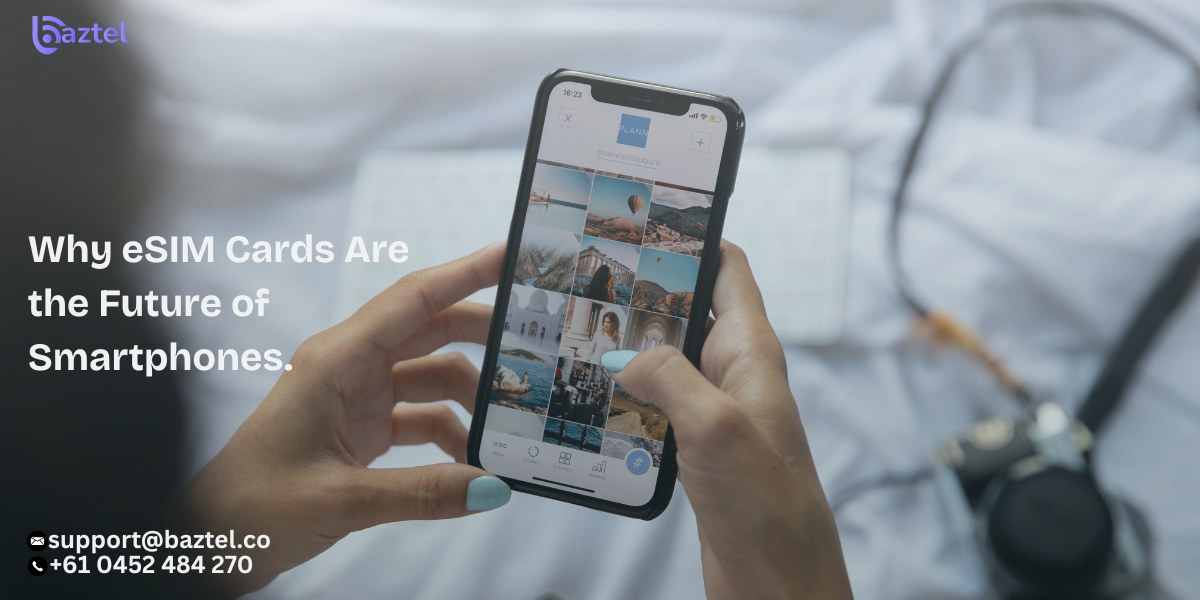Why eSIM Cards Are the Future of Smartphones.

Strong 8k brings an ultra-HD IPTV experience to your living room and your pocket.
Introduction
In an increasingly connected world, the humble Subscriber Identity Module (SIM) card has been the silent workhorse of mobile communication for decades. From the credit card-sized behemoths of early mobile phones to the tiny nano-SIMs we use today, the physical SIM has undergone several transformations. However, a new evolution is rapidly taking hold: the eSIM, or embedded SIM. This digital innovation is poised to redefine how we connect, manage our mobile services, and interact with our smartphones, signaling a significant shift in the telecommunications landscape.
What is an eSIM?
An eSIM is a digital SIM that is embedded directly into a device’s hardware during manufacturing, eliminating the need for a physical, removable card. Unlike traditional SIMs that require manual insertion and swapping, an eSIM is essentially a tiny, rewritable chip (eUICC) that can be remotely provisioned with network profiles. This means your mobile carrier information is downloaded and stored digitally on the chip, allowing you to activate a cellular plan without ever touching a physical SIM.
Comparison with Physical SIM Cards:
| Feature | Physical SIM Card | eSIM Card |
| Physicality | Removable plastic card | Embedded chip, non-removable |
| Provisioning | Requires physical insertion/swapping | Remote provisioning (downloaded digitally) |
| Space | Requires a SIM card slot, taking up device space | Saves space, allowing for smaller designs |
| Flexibility | Limited to one network profile at a time | Can store multiple network profiles simultaneously |
| Durability | Susceptible to damage, loss, or theft | Integrated, more resistant to physical damage/loss |
| Activation | Manual insertion, often requires store visit | Digital activation, often via QR code/app |
The Rise of eSIM Technology
eSIM technology has been gaining significant traction since its introduction by the GSMA in 2016. Major smartphone brands are rapidly adopting it, recognizing its potential to revolutionize user experience and device design.
1. Adoption by Major Smartphone Brands: Leading the charge are tech giants like Apple, Samsung, and Google, which have integrated eSIM functionality into many of their flagship devices. For instance, recent iPhone models (starting from iPhone XS/XR and onward, with US iPhone 14, 15, and 16 models being eSIM-only) have embraced this technology, pushing its mainstream adoption. Samsung's Galaxy S and Fold/Flip series, and Google's Pixel phones, also widely support eSIM. Other manufacturers like Huawei, Motorola, and Oppo are also increasingly incorporating eSIM into their device lineups.
2. Market Trends and Forecasts: The market for eSIM technology is experiencing robust growth. Reports indicate that the global eSIM market, valued at approximately USD 1.22 billion in 2023, is projected to grow significantly, reaching an estimated USD 6.29 billion by 2032, with a CAGR of around 20%. This growth is fueled by the increasing penetration of smartphones, wearables, and IoT devices, along with the growing demand for flexible and streamlined connectivity solutions. North America currently holds a dominant market share, driven by strong consumer demand and the early adoption efforts of major tech companies.
Benefits of eSIM Cards
The advantages of eSIM technology extend far beyond mere convenience, offering tangible improvements for both users and manufacturers.
1. Space-saving design: By eliminating the physical SIM card slot, manufacturers can free up valuable internal space within smartphones. This allows for sleeker, more compact designs, or enables the inclusion of larger batteries or other advanced components. It also reduces potential points of entry for dust and water, improving device durability.
2. Easier switching between carriers: One of the most significant benefits for consumers is the ability to switch mobile carriers or plans instantly, without needing a new physical SIM card. This is particularly useful for finding better deals, changing plans on the fly, or managing personal and business lines.
3. Better support for dual SIM functionality: eSIMs facilitate true dual-SIM functionality, allowing users to have two active numbers (e.g., a personal and a work number) on a single device, often combining one physical SIM with one or more eSIM profiles. Some devices can even store multiple eSIM profiles, enabling users to switch between them as needed.
4. Enhanced security and remote provisioning: eSIMs are inherently more secure than physical SIMs. Being embedded, they cannot be easily removed or swapped in case of theft, making SIM swap fraud more difficult. Remote provisioning capabilities also allow for over-the-air updates and deactivation of profiles, adding a layer of security and control.
How eSIMs Are Changing the User Experience
eSIMs are fundamentally transforming how users interact with their mobile connectivity, making it more seamless and intuitive.
1. Seamless setup and activation: Gone are the days of fumbling with tiny SIM trays and ejector tools. Activating an eSIM is often as simple as scanning a QR code provided by your carrier or downloading a profile through your phone's settings. This digital process is quick, convenient, and can be done from almost anywhere with an internet connection.
2. Improved connectivity for travelers: For frequent travelers, eSIMs are a game-changer. Instead of relying on expensive international roaming or hunting for local physical SIM cards upon arrival, travelers can simply download a local eSIM profile for data and calls in their destination country, often at significantly lower costs. This ensures continuous connectivity and eliminates the hassle of physical SIM swapping.
3. Support for wearable and IoT devices: The compact nature of eSIMs makes them ideal for smaller devices where a physical SIM slot is impractical. This includes smartwatches, fitness trackers, connected cars, and a wide array of Internet of Things (IoT) devices. eSIMs enable these devices to have independent cellular connectivity, expanding their functionality and creating a more interconnected ecosystem.
eSIM and the Future of Connectivity
The impact of eSIM extends far beyond smartphones, playing a pivotal role in the evolution of future communication technologies.
1. Role in 5G, IoT, and smart ecosystems: As 5G networks continue to roll out, enabling faster speeds and lower latency, eSIMs are crucial for unlocking their full potential. They facilitate seamless connectivity for the growing number of 5G-enabled IoT devices, from smart home appliances to industrial sensors. In smart cities and complex ecosystems, eSIMs will provide the flexible and scalable connectivity required for millions of interconnected devices.
2. Potential for carrier competition and better plans: The ease of switching carriers with an eSIM could foster greater competition among mobile network operators. Users will find it simpler to compare and switch to plans that offer better value, potentially driving down costs and improving service quality across the industry. This could lead to more innovative and flexible data plans tailored to specific user needs.
Challenges and Limitations
Despite its numerous advantages, eSIM technology still faces certain hurdles that need to be addressed for widespread, seamless adoption.
1. Compatibility issues with older devices: A significant limitation is that eSIM functionality is primarily found in newer, often premium, smartphone models. Older or budget-friendly devices may not have the embedded chip required for eSIM, meaning a complete transition for all users will take time.
2. Limited carrier support in some regions: While major global carriers and many national operators support eSIM, its availability can still be limited in certain regions or with smaller, local carriers. This can pose a challenge for users in areas where eSIM infrastructure is not yet fully developed.
3. Consumer privacy and data concerns: Because an eSIM is embedded, it cannot be physically removed from a device, which raises concerns for some users regarding continuous tracking or the inability to quickly "go off-grid" by simply removing their SIM. While eSIMs generally offer enhanced security features, robust protocols and user education are essential to address these privacy perceptions.
4. Difficulty in device switching (in some scenarios): While easy for everyday use, if a phone is severely damaged or lost, transferring an eSIM profile to a new device might require contacting the carrier for re-provisioning, which can be less instantaneous than simply moving a physical SIM.
Major Brands Leading the eSIM Revolution
The shift towards eSIM has been spearheaded by key players in the smartphone industry.
Apple, Samsung, Google, and others:
1. Apple: A major pioneer, Apple has aggressively adopted eSIM across its iPhone lineup (iPhone XR and later models), with the US market transitioning to eSIM-only for iPhone 14 and beyond. Their iPads and Apple Watches also widely support eSIM.
2. Samsung: Samsung offers eSIM support in its flagship Galaxy S series (S20 onwards), Note series, and its foldable phones (Z Fold and Z Flip series), as well as many of its smartwatches.
3. Google: Google's Pixel phones (Pixel 3 onwards) have consistently included eSIM functionality, providing a seamless experience for Android users.
4. Other key players: Brands like Huawei (P40, Mate 40 Pro), Motorola (Razr series, Edge series), Oppo (Find X series, Reno series), Xiaomi, and even some laptop and tablet manufacturers (e.g., Microsoft Surface, select Acer, ASUS, HP, and Lenovo models) are integrating eSIM, expanding its reach across various device categories.
How to Switch to an eSIM
The process of switching to an eSIM is generally straightforward, though it can vary slightly depending on your device and carrier.
Simple steps for activation:
1. Check Device Compatibility: Ensure your smartphone supports eSIM. Most newer flagship models from Apple, Samsung, and Google do.
2. Contact Your Carrier: Reach out to your mobile network provider (e.g., Airtel, Jio, Vodafone Idea in India) to request an eSIM. They will usually provide you with an activation QR code, either digitally via email or through their app.
3. Scan the QR Code: On your smartphone, navigate to your mobile network settings (usually under "Settings" > "Mobile Data" or "Connections" > "SIM Manager"). Look for an option to "Add eSIM" or "Add Mobile Plan."
4. Follow On-Screen Prompts: Your phone's camera will open to scan the QR code. Once scanned, follow the prompts to download and activate your eSIM profile. This may involve confirming settings or choosing whether it's for primary use, data only, etc.
5. Restart Device: After activation, it's often recommended to restart your device. Your new eSIM profile should then be active.
Things to consider before making the switch:
1. Internet Connection: You will need a stable internet connection (Wi-Fi is recommended) during the eSIM activation process to download the profile.
2. Carrier Support: Confirm that your current carrier supports eSIM for your specific plan and device.
3. Device Backup: It's always a good practice to back up your phone before making significant changes to its network settings.
4. Old SIM Deactivation: If you're converting your existing physical SIM to an eSIM, your carrier will usually deactivate the physical SIM once the eSIM is live. Keep your physical SIM safe until the eSIM is fully functional.
5. Device Transfer: If you frequently switch phones, remember that an eSIM needs to be re-provisioned on the new device, which might involve a call to your carrier, unlike simply moving a physical SIM.
Conclusion
The journey from bulky physical SIM cards to the invisible, embedded eSIM marks a pivotal moment in mobile technology. eSIMs offer unparalleled convenience, flexibility, and enhanced security, streamlining the user experience and opening up new possibilities for device design and connectivity. As 5G networks expand and the Internet of Things proliferates, eSIM technology will undoubtedly be a cornerstone of our increasingly interconnected lives. While challenges like device compatibility and carrier support in certain regions persist, the momentum behind eSIM is undeniable. It's not just an incremental upgrade; it's a fundamental shift that positions eSIM cards as the inevitable future of smartphones and indeed, of connectivity itself.
Note: IndiBlogHub features both user-submitted and editorial content. We do not verify third-party contributions. Read our Disclaimer and Privacy Policyfor details.



